Culture, Power, and Change Management: A Comparative Analysis Essay
VerifiedAdded on 2021/04/21
|8
|2787
|76
Essay
AI Summary
This essay delves into the complexities of organizational change management, examining the influence of cultural factors and power dynamics within Singaporean and Australian contexts. It utilizes Hofstede's cultural dimensions model to analyze cultural aspects like power distance, individualism, and masculinity, comparing the two countries. The essay further explores how national culture influences the five bases of power (reward, legitimate, coercive, expert, and referent) as defined by French and Raven. It highlights the significance of these power dynamics in shaping leadership behavior and decision-making processes within organizations. The analysis emphasizes the need for leaders to adapt their approaches based on cultural nuances and situational contingencies to successfully implement change programs and achieve optimal resource utilization.
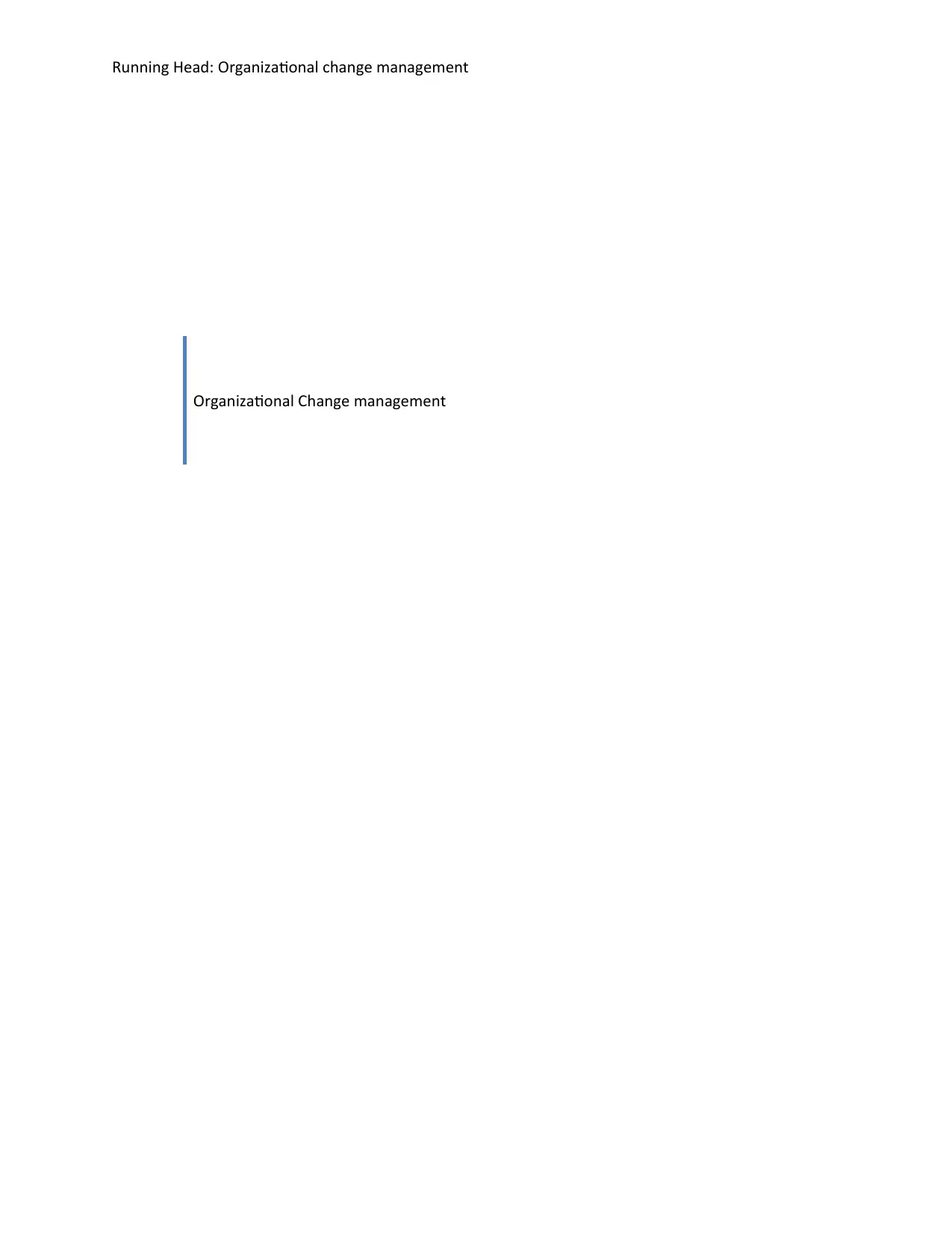
Running Head: Organizational change management
Organizational Change management
Organizational Change management
Paraphrase This Document
Need a fresh take? Get an instant paraphrase of this document with our AI Paraphraser
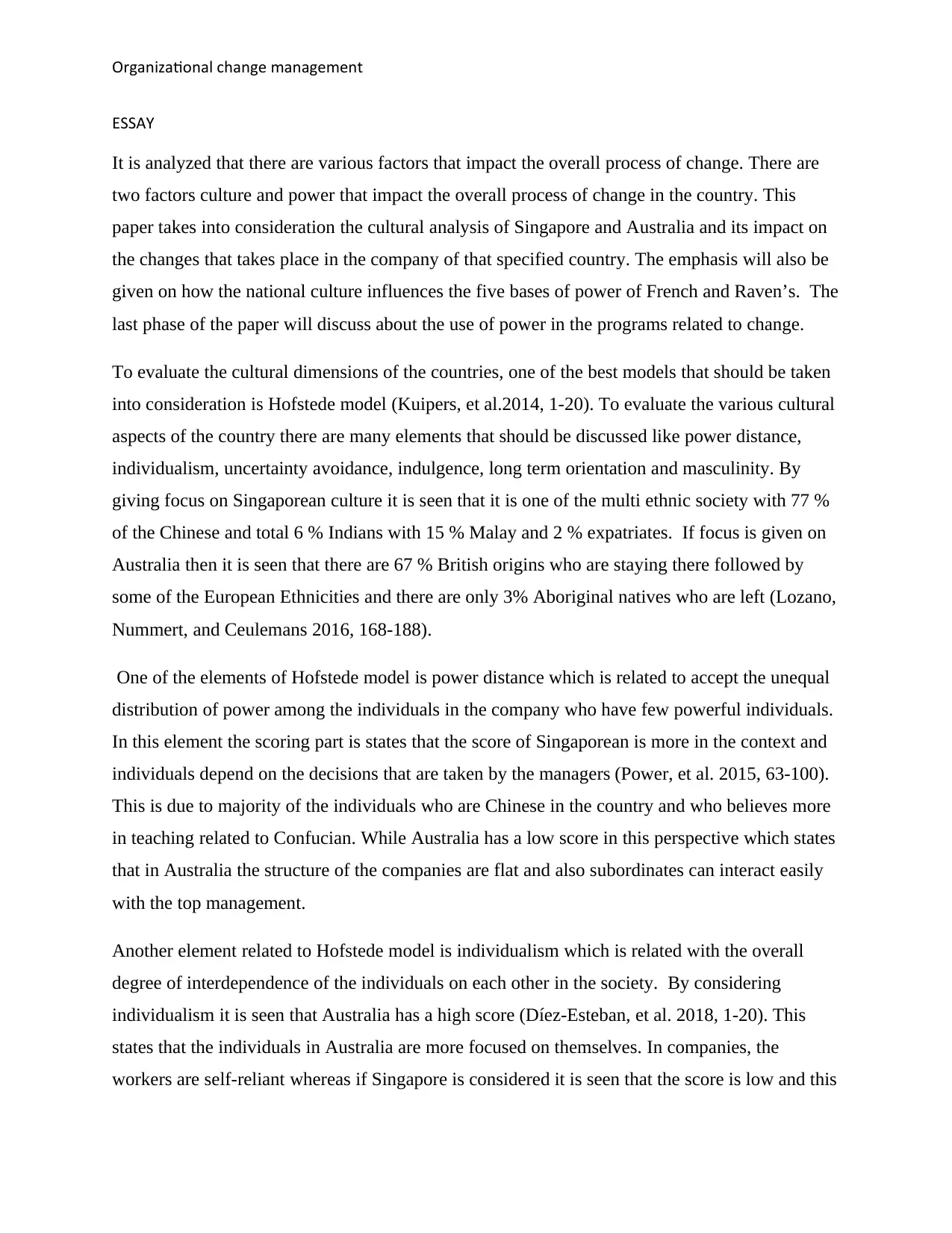
Organizational change management
ESSAY
It is analyzed that there are various factors that impact the overall process of change. There are
two factors culture and power that impact the overall process of change in the country. This
paper takes into consideration the cultural analysis of Singapore and Australia and its impact on
the changes that takes place in the company of that specified country. The emphasis will also be
given on how the national culture influences the five bases of power of French and Raven’s. The
last phase of the paper will discuss about the use of power in the programs related to change.
To evaluate the cultural dimensions of the countries, one of the best models that should be taken
into consideration is Hofstede model (Kuipers, et al.2014, 1-20). To evaluate the various cultural
aspects of the country there are many elements that should be discussed like power distance,
individualism, uncertainty avoidance, indulgence, long term orientation and masculinity. By
giving focus on Singaporean culture it is seen that it is one of the multi ethnic society with 77 %
of the Chinese and total 6 % Indians with 15 % Malay and 2 % expatriates. If focus is given on
Australia then it is seen that there are 67 % British origins who are staying there followed by
some of the European Ethnicities and there are only 3% Aboriginal natives who are left (Lozano,
Nummert, and Ceulemans 2016, 168-188).
One of the elements of Hofstede model is power distance which is related to accept the unequal
distribution of power among the individuals in the company who have few powerful individuals.
In this element the scoring part is states that the score of Singaporean is more in the context and
individuals depend on the decisions that are taken by the managers (Power, et al. 2015, 63-100).
This is due to majority of the individuals who are Chinese in the country and who believes more
in teaching related to Confucian. While Australia has a low score in this perspective which states
that in Australia the structure of the companies are flat and also subordinates can interact easily
with the top management.
Another element related to Hofstede model is individualism which is related with the overall
degree of interdependence of the individuals on each other in the society. By considering
individualism it is seen that Australia has a high score (Díez-Esteban, et al. 2018, 1-20). This
states that the individuals in Australia are more focused on themselves. In companies, the
workers are self-reliant whereas if Singapore is considered it is seen that the score is low and this
ESSAY
It is analyzed that there are various factors that impact the overall process of change. There are
two factors culture and power that impact the overall process of change in the country. This
paper takes into consideration the cultural analysis of Singapore and Australia and its impact on
the changes that takes place in the company of that specified country. The emphasis will also be
given on how the national culture influences the five bases of power of French and Raven’s. The
last phase of the paper will discuss about the use of power in the programs related to change.
To evaluate the cultural dimensions of the countries, one of the best models that should be taken
into consideration is Hofstede model (Kuipers, et al.2014, 1-20). To evaluate the various cultural
aspects of the country there are many elements that should be discussed like power distance,
individualism, uncertainty avoidance, indulgence, long term orientation and masculinity. By
giving focus on Singaporean culture it is seen that it is one of the multi ethnic society with 77 %
of the Chinese and total 6 % Indians with 15 % Malay and 2 % expatriates. If focus is given on
Australia then it is seen that there are 67 % British origins who are staying there followed by
some of the European Ethnicities and there are only 3% Aboriginal natives who are left (Lozano,
Nummert, and Ceulemans 2016, 168-188).
One of the elements of Hofstede model is power distance which is related to accept the unequal
distribution of power among the individuals in the company who have few powerful individuals.
In this element the scoring part is states that the score of Singaporean is more in the context and
individuals depend on the decisions that are taken by the managers (Power, et al. 2015, 63-100).
This is due to majority of the individuals who are Chinese in the country and who believes more
in teaching related to Confucian. While Australia has a low score in this perspective which states
that in Australia the structure of the companies are flat and also subordinates can interact easily
with the top management.
Another element related to Hofstede model is individualism which is related with the overall
degree of interdependence of the individuals on each other in the society. By considering
individualism it is seen that Australia has a high score (Díez-Esteban, et al. 2018, 1-20). This
states that the individuals in Australia are more focused on themselves. In companies, the
workers are self-reliant whereas if Singapore is considered it is seen that the score is low and this
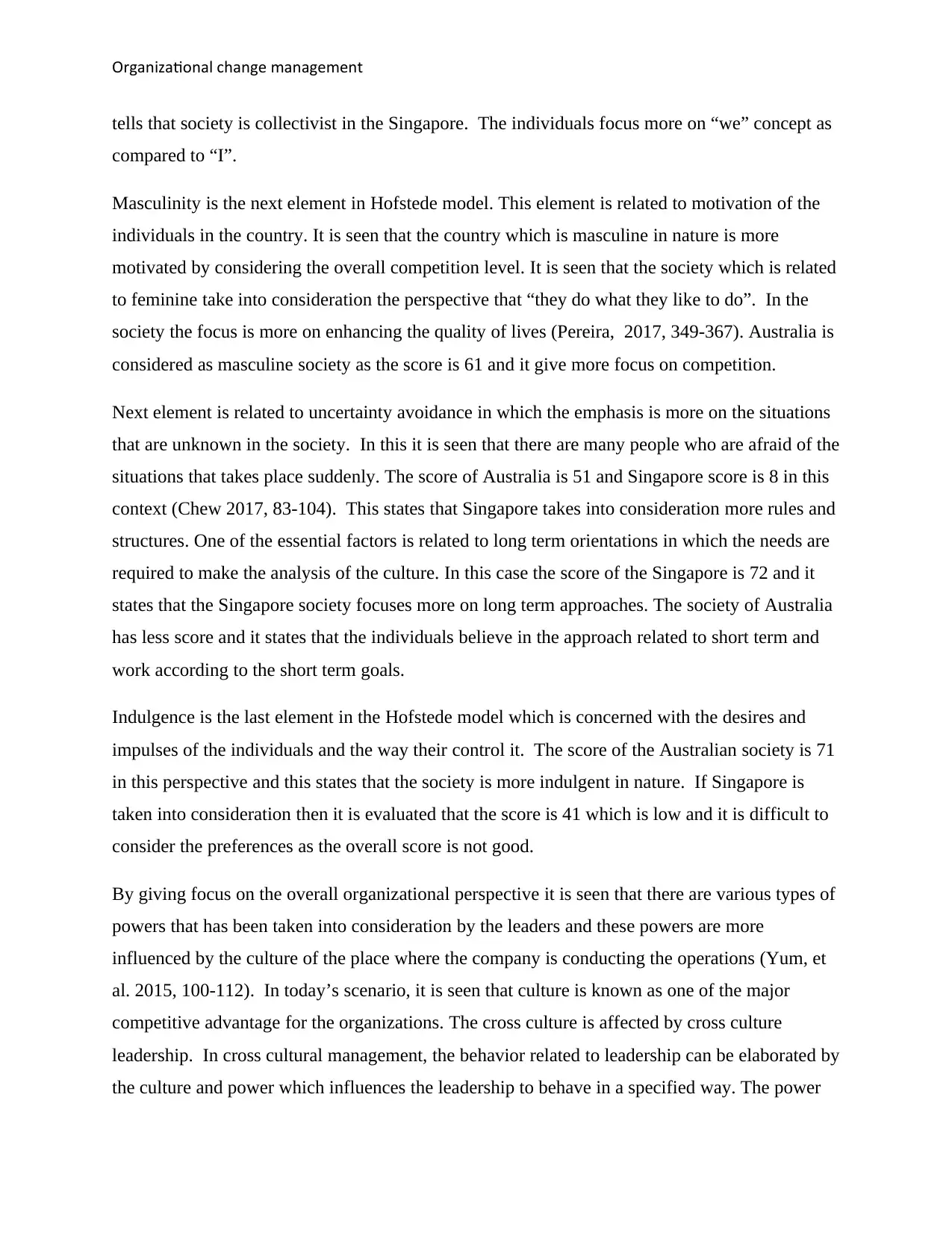
Organizational change management
tells that society is collectivist in the Singapore. The individuals focus more on “we” concept as
compared to “I”.
Masculinity is the next element in Hofstede model. This element is related to motivation of the
individuals in the country. It is seen that the country which is masculine in nature is more
motivated by considering the overall competition level. It is seen that the society which is related
to feminine take into consideration the perspective that “they do what they like to do”. In the
society the focus is more on enhancing the quality of lives (Pereira, 2017, 349-367). Australia is
considered as masculine society as the score is 61 and it give more focus on competition.
Next element is related to uncertainty avoidance in which the emphasis is more on the situations
that are unknown in the society. In this it is seen that there are many people who are afraid of the
situations that takes place suddenly. The score of Australia is 51 and Singapore score is 8 in this
context (Chew 2017, 83-104). This states that Singapore takes into consideration more rules and
structures. One of the essential factors is related to long term orientations in which the needs are
required to make the analysis of the culture. In this case the score of the Singapore is 72 and it
states that the Singapore society focuses more on long term approaches. The society of Australia
has less score and it states that the individuals believe in the approach related to short term and
work according to the short term goals.
Indulgence is the last element in the Hofstede model which is concerned with the desires and
impulses of the individuals and the way their control it. The score of the Australian society is 71
in this perspective and this states that the society is more indulgent in nature. If Singapore is
taken into consideration then it is evaluated that the score is 41 which is low and it is difficult to
consider the preferences as the overall score is not good.
By giving focus on the overall organizational perspective it is seen that there are various types of
powers that has been taken into consideration by the leaders and these powers are more
influenced by the culture of the place where the company is conducting the operations (Yum, et
al. 2015, 100-112). In today’s scenario, it is seen that culture is known as one of the major
competitive advantage for the organizations. The cross culture is affected by cross culture
leadership. In cross cultural management, the behavior related to leadership can be elaborated by
the culture and power which influences the leadership to behave in a specified way. The power
tells that society is collectivist in the Singapore. The individuals focus more on “we” concept as
compared to “I”.
Masculinity is the next element in Hofstede model. This element is related to motivation of the
individuals in the country. It is seen that the country which is masculine in nature is more
motivated by considering the overall competition level. It is seen that the society which is related
to feminine take into consideration the perspective that “they do what they like to do”. In the
society the focus is more on enhancing the quality of lives (Pereira, 2017, 349-367). Australia is
considered as masculine society as the score is 61 and it give more focus on competition.
Next element is related to uncertainty avoidance in which the emphasis is more on the situations
that are unknown in the society. In this it is seen that there are many people who are afraid of the
situations that takes place suddenly. The score of Australia is 51 and Singapore score is 8 in this
context (Chew 2017, 83-104). This states that Singapore takes into consideration more rules and
structures. One of the essential factors is related to long term orientations in which the needs are
required to make the analysis of the culture. In this case the score of the Singapore is 72 and it
states that the Singapore society focuses more on long term approaches. The society of Australia
has less score and it states that the individuals believe in the approach related to short term and
work according to the short term goals.
Indulgence is the last element in the Hofstede model which is concerned with the desires and
impulses of the individuals and the way their control it. The score of the Australian society is 71
in this perspective and this states that the society is more indulgent in nature. If Singapore is
taken into consideration then it is evaluated that the score is 41 which is low and it is difficult to
consider the preferences as the overall score is not good.
By giving focus on the overall organizational perspective it is seen that there are various types of
powers that has been taken into consideration by the leaders and these powers are more
influenced by the culture of the place where the company is conducting the operations (Yum, et
al. 2015, 100-112). In today’s scenario, it is seen that culture is known as one of the major
competitive advantage for the organizations. The cross culture is affected by cross culture
leadership. In cross cultural management, the behavior related to leadership can be elaborated by
the culture and power which influences the leadership to behave in a specified way. The power
⊘ This is a preview!⊘
Do you want full access?
Subscribe today to unlock all pages.

Trusted by 1+ million students worldwide
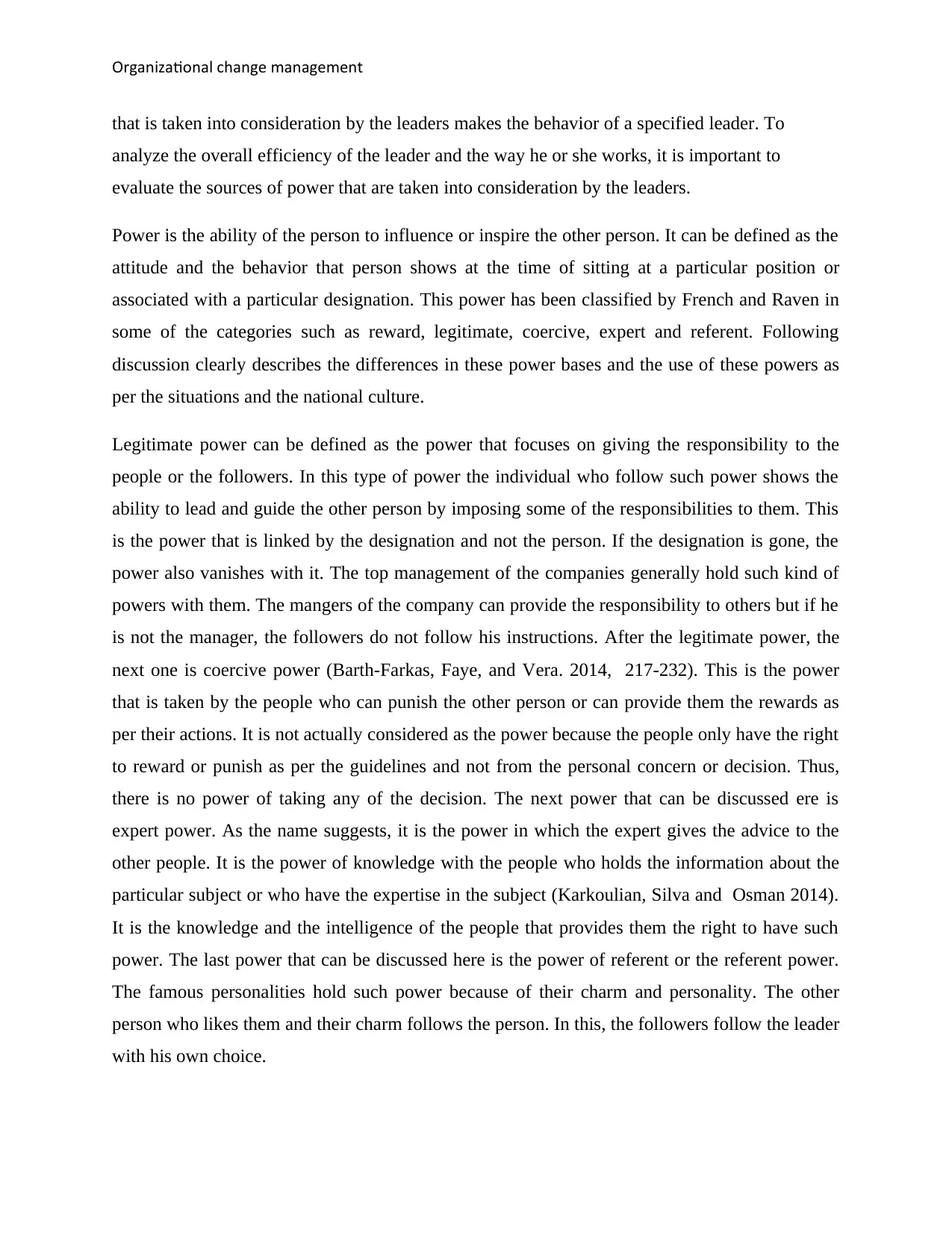
Organizational change management
that is taken into consideration by the leaders makes the behavior of a specified leader. To
analyze the overall efficiency of the leader and the way he or she works, it is important to
evaluate the sources of power that are taken into consideration by the leaders.
Power is the ability of the person to influence or inspire the other person. It can be defined as the
attitude and the behavior that person shows at the time of sitting at a particular position or
associated with a particular designation. This power has been classified by French and Raven in
some of the categories such as reward, legitimate, coercive, expert and referent. Following
discussion clearly describes the differences in these power bases and the use of these powers as
per the situations and the national culture.
Legitimate power can be defined as the power that focuses on giving the responsibility to the
people or the followers. In this type of power the individual who follow such power shows the
ability to lead and guide the other person by imposing some of the responsibilities to them. This
is the power that is linked by the designation and not the person. If the designation is gone, the
power also vanishes with it. The top management of the companies generally hold such kind of
powers with them. The mangers of the company can provide the responsibility to others but if he
is not the manager, the followers do not follow his instructions. After the legitimate power, the
next one is coercive power (Barth-Farkas, Faye, and Vera. 2014, 217-232). This is the power
that is taken by the people who can punish the other person or can provide them the rewards as
per their actions. It is not actually considered as the power because the people only have the right
to reward or punish as per the guidelines and not from the personal concern or decision. Thus,
there is no power of taking any of the decision. The next power that can be discussed ere is
expert power. As the name suggests, it is the power in which the expert gives the advice to the
other people. It is the power of knowledge with the people who holds the information about the
particular subject or who have the expertise in the subject (Karkoulian, Silva and Osman 2014).
It is the knowledge and the intelligence of the people that provides them the right to have such
power. The last power that can be discussed here is the power of referent or the referent power.
The famous personalities hold such power because of their charm and personality. The other
person who likes them and their charm follows the person. In this, the followers follow the leader
with his own choice.
that is taken into consideration by the leaders makes the behavior of a specified leader. To
analyze the overall efficiency of the leader and the way he or she works, it is important to
evaluate the sources of power that are taken into consideration by the leaders.
Power is the ability of the person to influence or inspire the other person. It can be defined as the
attitude and the behavior that person shows at the time of sitting at a particular position or
associated with a particular designation. This power has been classified by French and Raven in
some of the categories such as reward, legitimate, coercive, expert and referent. Following
discussion clearly describes the differences in these power bases and the use of these powers as
per the situations and the national culture.
Legitimate power can be defined as the power that focuses on giving the responsibility to the
people or the followers. In this type of power the individual who follow such power shows the
ability to lead and guide the other person by imposing some of the responsibilities to them. This
is the power that is linked by the designation and not the person. If the designation is gone, the
power also vanishes with it. The top management of the companies generally hold such kind of
powers with them. The mangers of the company can provide the responsibility to others but if he
is not the manager, the followers do not follow his instructions. After the legitimate power, the
next one is coercive power (Barth-Farkas, Faye, and Vera. 2014, 217-232). This is the power
that is taken by the people who can punish the other person or can provide them the rewards as
per their actions. It is not actually considered as the power because the people only have the right
to reward or punish as per the guidelines and not from the personal concern or decision. Thus,
there is no power of taking any of the decision. The next power that can be discussed ere is
expert power. As the name suggests, it is the power in which the expert gives the advice to the
other people. It is the power of knowledge with the people who holds the information about the
particular subject or who have the expertise in the subject (Karkoulian, Silva and Osman 2014).
It is the knowledge and the intelligence of the people that provides them the right to have such
power. The last power that can be discussed here is the power of referent or the referent power.
The famous personalities hold such power because of their charm and personality. The other
person who likes them and their charm follows the person. In this, the followers follow the leader
with his own choice.
Paraphrase This Document
Need a fresh take? Get an instant paraphrase of this document with our AI Paraphraser
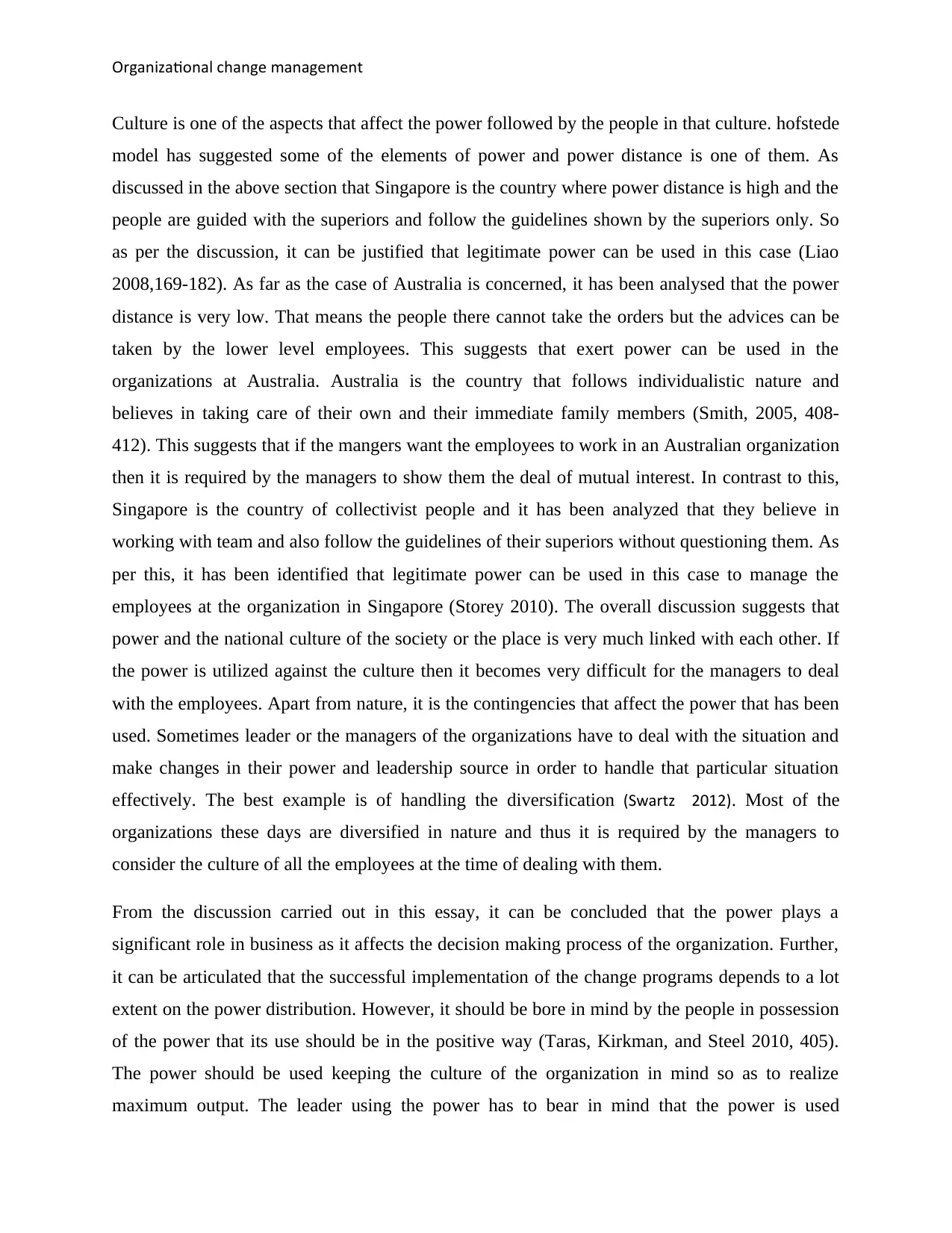
Organizational change management
Culture is one of the aspects that affect the power followed by the people in that culture. hofstede
model has suggested some of the elements of power and power distance is one of them. As
discussed in the above section that Singapore is the country where power distance is high and the
people are guided with the superiors and follow the guidelines shown by the superiors only. So
as per the discussion, it can be justified that legitimate power can be used in this case (Liao
2008,169-182). As far as the case of Australia is concerned, it has been analysed that the power
distance is very low. That means the people there cannot take the orders but the advices can be
taken by the lower level employees. This suggests that exert power can be used in the
organizations at Australia. Australia is the country that follows individualistic nature and
believes in taking care of their own and their immediate family members (Smith, 2005, 408-
412). This suggests that if the mangers want the employees to work in an Australian organization
then it is required by the managers to show them the deal of mutual interest. In contrast to this,
Singapore is the country of collectivist people and it has been analyzed that they believe in
working with team and also follow the guidelines of their superiors without questioning them. As
per this, it has been identified that legitimate power can be used in this case to manage the
employees at the organization in Singapore (Storey 2010). The overall discussion suggests that
power and the national culture of the society or the place is very much linked with each other. If
the power is utilized against the culture then it becomes very difficult for the managers to deal
with the employees. Apart from nature, it is the contingencies that affect the power that has been
used. Sometimes leader or the managers of the organizations have to deal with the situation and
make changes in their power and leadership source in order to handle that particular situation
effectively. The best example is of handling the diversification (Swartz 2012). Most of the
organizations these days are diversified in nature and thus it is required by the managers to
consider the culture of all the employees at the time of dealing with them.
From the discussion carried out in this essay, it can be concluded that the power plays a
significant role in business as it affects the decision making process of the organization. Further,
it can be articulated that the successful implementation of the change programs depends to a lot
extent on the power distribution. However, it should be bore in mind by the people in possession
of the power that its use should be in the positive way (Taras, Kirkman, and Steel 2010, 405).
The power should be used keeping the culture of the organization in mind so as to realize
maximum output. The leader using the power has to bear in mind that the power is used
Culture is one of the aspects that affect the power followed by the people in that culture. hofstede
model has suggested some of the elements of power and power distance is one of them. As
discussed in the above section that Singapore is the country where power distance is high and the
people are guided with the superiors and follow the guidelines shown by the superiors only. So
as per the discussion, it can be justified that legitimate power can be used in this case (Liao
2008,169-182). As far as the case of Australia is concerned, it has been analysed that the power
distance is very low. That means the people there cannot take the orders but the advices can be
taken by the lower level employees. This suggests that exert power can be used in the
organizations at Australia. Australia is the country that follows individualistic nature and
believes in taking care of their own and their immediate family members (Smith, 2005, 408-
412). This suggests that if the mangers want the employees to work in an Australian organization
then it is required by the managers to show them the deal of mutual interest. In contrast to this,
Singapore is the country of collectivist people and it has been analyzed that they believe in
working with team and also follow the guidelines of their superiors without questioning them. As
per this, it has been identified that legitimate power can be used in this case to manage the
employees at the organization in Singapore (Storey 2010). The overall discussion suggests that
power and the national culture of the society or the place is very much linked with each other. If
the power is utilized against the culture then it becomes very difficult for the managers to deal
with the employees. Apart from nature, it is the contingencies that affect the power that has been
used. Sometimes leader or the managers of the organizations have to deal with the situation and
make changes in their power and leadership source in order to handle that particular situation
effectively. The best example is of handling the diversification (Swartz 2012). Most of the
organizations these days are diversified in nature and thus it is required by the managers to
consider the culture of all the employees at the time of dealing with them.
From the discussion carried out in this essay, it can be concluded that the power plays a
significant role in business as it affects the decision making process of the organization. Further,
it can be articulated that the successful implementation of the change programs depends to a lot
extent on the power distribution. However, it should be bore in mind by the people in possession
of the power that its use should be in the positive way (Taras, Kirkman, and Steel 2010, 405).
The power should be used keeping the culture of the organization in mind so as to realize
maximum output. The leader using the power has to bear in mind that the power is used
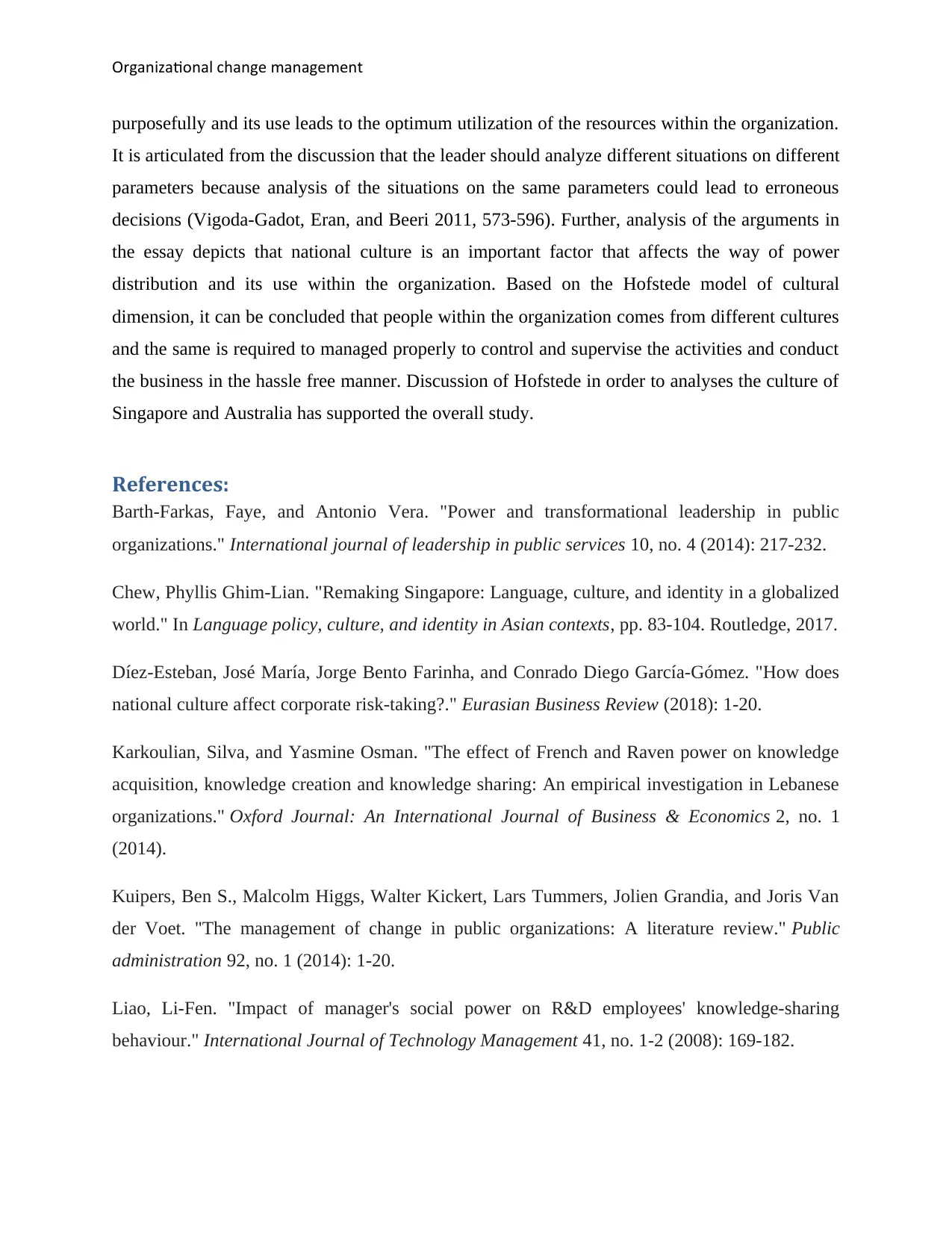
Organizational change management
purposefully and its use leads to the optimum utilization of the resources within the organization.
It is articulated from the discussion that the leader should analyze different situations on different
parameters because analysis of the situations on the same parameters could lead to erroneous
decisions (Vigoda-Gadot, Eran, and Beeri 2011, 573-596). Further, analysis of the arguments in
the essay depicts that national culture is an important factor that affects the way of power
distribution and its use within the organization. Based on the Hofstede model of cultural
dimension, it can be concluded that people within the organization comes from different cultures
and the same is required to managed properly to control and supervise the activities and conduct
the business in the hassle free manner. Discussion of Hofstede in order to analyses the culture of
Singapore and Australia has supported the overall study.
References:
Barth-Farkas, Faye, and Antonio Vera. "Power and transformational leadership in public
organizations." International journal of leadership in public services 10, no. 4 (2014): 217-232.
Chew, Phyllis Ghim-Lian. "Remaking Singapore: Language, culture, and identity in a globalized
world." In Language policy, culture, and identity in Asian contexts, pp. 83-104. Routledge, 2017.
Díez-Esteban, José María, Jorge Bento Farinha, and Conrado Diego García-Gómez. "How does
national culture affect corporate risk-taking?." Eurasian Business Review (2018): 1-20.
Karkoulian, Silva, and Yasmine Osman. "The effect of French and Raven power on knowledge
acquisition, knowledge creation and knowledge sharing: An empirical investigation in Lebanese
organizations." Oxford Journal: An International Journal of Business & Economics 2, no. 1
(2014).
Kuipers, Ben S., Malcolm Higgs, Walter Kickert, Lars Tummers, Jolien Grandia, and Joris Van
der Voet. "The management of change in public organizations: A literature review." Public
administration 92, no. 1 (2014): 1-20.
Liao, Li-Fen. "Impact of manager's social power on R&D employees' knowledge-sharing
behaviour." International Journal of Technology Management 41, no. 1-2 (2008): 169-182.
purposefully and its use leads to the optimum utilization of the resources within the organization.
It is articulated from the discussion that the leader should analyze different situations on different
parameters because analysis of the situations on the same parameters could lead to erroneous
decisions (Vigoda-Gadot, Eran, and Beeri 2011, 573-596). Further, analysis of the arguments in
the essay depicts that national culture is an important factor that affects the way of power
distribution and its use within the organization. Based on the Hofstede model of cultural
dimension, it can be concluded that people within the organization comes from different cultures
and the same is required to managed properly to control and supervise the activities and conduct
the business in the hassle free manner. Discussion of Hofstede in order to analyses the culture of
Singapore and Australia has supported the overall study.
References:
Barth-Farkas, Faye, and Antonio Vera. "Power and transformational leadership in public
organizations." International journal of leadership in public services 10, no. 4 (2014): 217-232.
Chew, Phyllis Ghim-Lian. "Remaking Singapore: Language, culture, and identity in a globalized
world." In Language policy, culture, and identity in Asian contexts, pp. 83-104. Routledge, 2017.
Díez-Esteban, José María, Jorge Bento Farinha, and Conrado Diego García-Gómez. "How does
national culture affect corporate risk-taking?." Eurasian Business Review (2018): 1-20.
Karkoulian, Silva, and Yasmine Osman. "The effect of French and Raven power on knowledge
acquisition, knowledge creation and knowledge sharing: An empirical investigation in Lebanese
organizations." Oxford Journal: An International Journal of Business & Economics 2, no. 1
(2014).
Kuipers, Ben S., Malcolm Higgs, Walter Kickert, Lars Tummers, Jolien Grandia, and Joris Van
der Voet. "The management of change in public organizations: A literature review." Public
administration 92, no. 1 (2014): 1-20.
Liao, Li-Fen. "Impact of manager's social power on R&D employees' knowledge-sharing
behaviour." International Journal of Technology Management 41, no. 1-2 (2008): 169-182.
⊘ This is a preview!⊘
Do you want full access?
Subscribe today to unlock all pages.

Trusted by 1+ million students worldwide
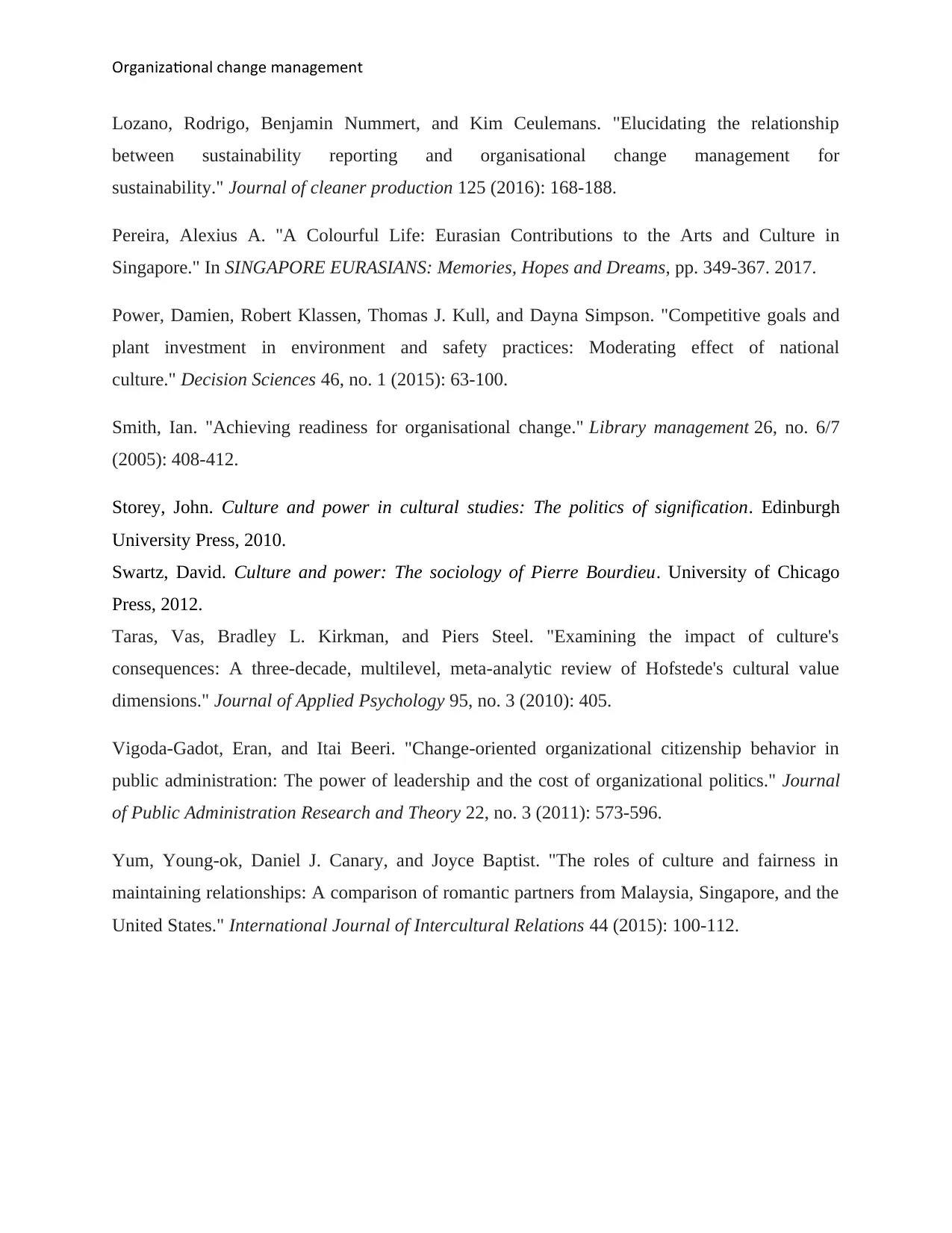
Organizational change management
Lozano, Rodrigo, Benjamin Nummert, and Kim Ceulemans. "Elucidating the relationship
between sustainability reporting and organisational change management for
sustainability." Journal of cleaner production 125 (2016): 168-188.
Pereira, Alexius A. "A Colourful Life: Eurasian Contributions to the Arts and Culture in
Singapore." In SINGAPORE EURASIANS: Memories, Hopes and Dreams, pp. 349-367. 2017.
Power, Damien, Robert Klassen, Thomas J. Kull, and Dayna Simpson. "Competitive goals and
plant investment in environment and safety practices: Moderating effect of national
culture." Decision Sciences 46, no. 1 (2015): 63-100.
Smith, Ian. "Achieving readiness for organisational change." Library management 26, no. 6/7
(2005): 408-412.
Storey, John. Culture and power in cultural studies: The politics of signification. Edinburgh
University Press, 2010.
Swartz, David. Culture and power: The sociology of Pierre Bourdieu. University of Chicago
Press, 2012.
Taras, Vas, Bradley L. Kirkman, and Piers Steel. "Examining the impact of culture's
consequences: A three-decade, multilevel, meta-analytic review of Hofstede's cultural value
dimensions." Journal of Applied Psychology 95, no. 3 (2010): 405.
Vigoda-Gadot, Eran, and Itai Beeri. "Change-oriented organizational citizenship behavior in
public administration: The power of leadership and the cost of organizational politics." Journal
of Public Administration Research and Theory 22, no. 3 (2011): 573-596.
Yum, Young-ok, Daniel J. Canary, and Joyce Baptist. "The roles of culture and fairness in
maintaining relationships: A comparison of romantic partners from Malaysia, Singapore, and the
United States." International Journal of Intercultural Relations 44 (2015): 100-112.
Lozano, Rodrigo, Benjamin Nummert, and Kim Ceulemans. "Elucidating the relationship
between sustainability reporting and organisational change management for
sustainability." Journal of cleaner production 125 (2016): 168-188.
Pereira, Alexius A. "A Colourful Life: Eurasian Contributions to the Arts and Culture in
Singapore." In SINGAPORE EURASIANS: Memories, Hopes and Dreams, pp. 349-367. 2017.
Power, Damien, Robert Klassen, Thomas J. Kull, and Dayna Simpson. "Competitive goals and
plant investment in environment and safety practices: Moderating effect of national
culture." Decision Sciences 46, no. 1 (2015): 63-100.
Smith, Ian. "Achieving readiness for organisational change." Library management 26, no. 6/7
(2005): 408-412.
Storey, John. Culture and power in cultural studies: The politics of signification. Edinburgh
University Press, 2010.
Swartz, David. Culture and power: The sociology of Pierre Bourdieu. University of Chicago
Press, 2012.
Taras, Vas, Bradley L. Kirkman, and Piers Steel. "Examining the impact of culture's
consequences: A three-decade, multilevel, meta-analytic review of Hofstede's cultural value
dimensions." Journal of Applied Psychology 95, no. 3 (2010): 405.
Vigoda-Gadot, Eran, and Itai Beeri. "Change-oriented organizational citizenship behavior in
public administration: The power of leadership and the cost of organizational politics." Journal
of Public Administration Research and Theory 22, no. 3 (2011): 573-596.
Yum, Young-ok, Daniel J. Canary, and Joyce Baptist. "The roles of culture and fairness in
maintaining relationships: A comparison of romantic partners from Malaysia, Singapore, and the
United States." International Journal of Intercultural Relations 44 (2015): 100-112.
Paraphrase This Document
Need a fresh take? Get an instant paraphrase of this document with our AI Paraphraser

Organizational change management
1 out of 8
Related Documents
Your All-in-One AI-Powered Toolkit for Academic Success.
+13062052269
info@desklib.com
Available 24*7 on WhatsApp / Email
![[object Object]](/_next/static/media/star-bottom.7253800d.svg)
Unlock your academic potential
Copyright © 2020–2025 A2Z Services. All Rights Reserved. Developed and managed by ZUCOL.





